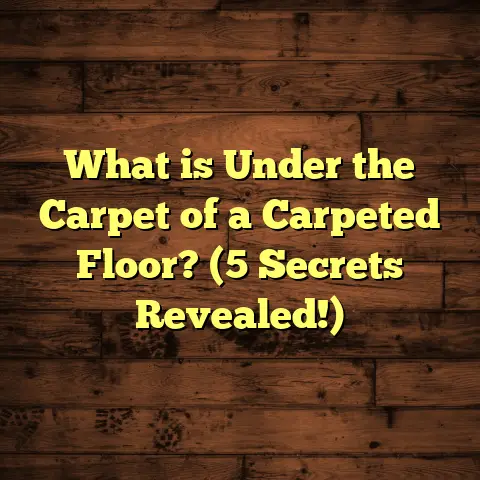What is Underlayment Flooring? (5 Key Benefits You Must Know!)
Waterproof flooring options have really changed the way I approach flooring projects. I still remember the first time a client asked me for a floor that could handle moisture without warping or damage. It was a basement renovation, and the homeowner was worried about water seepage ruining their new floors. That’s when I realized that underlayment plays a huge role in protecting floors, especially in areas exposed to moisture. If you’ve ever wondered how floors can be both beautiful and resilient against water, underlayment is a big part of the answer.
What is Underlayment Flooring?
So, what exactly is underlayment flooring? In the simplest terms, underlayment is a thin layer of material installed between your subfloor—the structural base—and your finished floor, like hardwood, laminate, or tile. It’s kind of like the foundation beneath a house but for your floor. Its job is to provide several key functions: cushioning, moisture protection, sound absorption, floor leveling, and even thermal insulation.
If you’ve ever noticed that some floors feel hollow or creaky when you walk on them, that’s often because there’s no or poor underlayment underneath. Good underlayment smooths out minor imperfections in the subfloor and acts as a buffer, which helps your finished floor last longer and feel better underfoot.
The type of underlayment you need depends on the flooring material and the room’s environment. For example:
- Laminate flooring typically uses foam or felt underlayment which adds cushioning and soundproofing.
- Hardwood flooring usually requires plywood or cork underlayment to provide stability.
- Tile floors often need cement board underlayment to create a rigid surface for the tile to stick to.
- Vinyl flooring benefits from waterproof underlayment with vapor barriers to prevent moisture damage.
The variety is vast, but the key takeaway is that underlayment is an essential part of the flooring system. It’s not just an optional accessory; it works behind the scenes to keep your floors looking good and performing well.
My Personal Experience with Underlayment
I had a client once who was renovating an old farmhouse. They wanted beautiful hardwood floors but were worried about the uneven subfloor and potential moisture issues common in older homes. I recommended a specific cork underlayment that offered moisture resistance, sound dampening, and slight cushioning.
After installation, the client told me that walking on the floors felt more comfortable than any hardwood they’d experienced before. Plus, the floors had no creaks or squeaks, which was a big relief given the age of the house. That project really stuck with me because it showed how the right underlayment can transform a floor from just “nice” to something truly enjoyable every day.
5 Key Benefits of Underlayment Flooring You Must Know
I’ve worked on so many flooring projects that some benefits of underlayment are obvious to me now—but not always to homeowners or even some contractors. Whether you’re doing a DIY project or hiring pros, here are five benefits you really want to know about.
1. Moisture Protection and Waterproofing
Moisture is one of the biggest enemies of any flooring system. Whether it’s spills in kitchens, humidity in basements, or condensation in bathrooms, water can cause warping, mold growth, and premature wear.
Approximately 30% of flooring failures in residential homes are linked directly to moisture damage. That’s why waterproof underlayment is so important in wet areas.
I remember working on a basement renovation where the homeowner wanted luxury vinyl planks (LVP). The LVP itself was waterproof, but without proper underlayment, the floor still felt cold and occasionally had a musty smell after heavy rains.
We installed an HDPE (high-density polyethylene) waterproof underlayment with an integrated vapor barrier. This not only blocked moisture from seeping upward but also prevented mold growth beneath the floor.
After six months, even with heavy rainfall outside causing increased basement humidity, the floor remained intact with no odor or damage. The client was relieved and pleased with how durable the floor was.
This is why I always recommend waterproof underlayments for basements, bathrooms, kitchens, and anywhere moisture might be present. It adds an extra layer of protection beyond what your flooring material offers.
2. Sound Insulation
Have you ever walked on laminate floors and been startled by how loud your footsteps echo? That hollow noise happens when there’s no sound-absorbing layer beneath.
Underlayment absorbs sound by cushioning the impact of footsteps and reducing noise transmission between floors. This benefit is especially noticeable in multi-story homes and apartments where noise can travel easily between levels.
Studies show that certain types of foam and cork underlayments can reduce sound transmission by up to 50% or more. In one project, I installed cork underlayment in an apartment above a busy street. The tenant reported immediate relief from street noise and quieter floors inside their unit.
If you live in a noisy environment or want to keep your home peaceful, choosing an underlayment with soundproofing qualities can make a big difference.
3. Comfort Underfoot
Walking barefoot on hard floors can sometimes feel cold or uncomfortable, especially in winter months or on concrete subfloors.
Underlayment adds a layer of softness that makes floors feel warmer and more pleasant to walk on. This cushioning effect also reduces foot fatigue when standing for long periods.
I worked on a house where radiant heating was installed beneath engineered hardwood floors combined with an insulated underlayment. The homeowners said their feet never felt cold again during winter, and the floor felt “softer” without losing any firmness.
This benefit is often overlooked but can dramatically improve daily comfort in your home.
4. Floor Leveling and Stability
Subfloors aren’t always perfectly flat or smooth. Small dips, bumps, or rough patches are common—especially in older homes or concrete slabs with imperfections.
Underlayment helps even out minor variations in the subfloor surface so your finished floor lays flat without gaps or cracks.
I encountered this on a kitchen remodel where the existing subfloor had several low spots. We used a plywood underlayment designed for leveling before installing tile on top.
The result was a flawless tile surface that didn’t crack over time due to uneven support underneath.
Having stable support beneath your flooring is vital for extending its lifespan and preventing costly repairs down the line.
5. Extending Flooring Lifespan
All these benefits combined—moisture protection, soundproofing, comfort, and leveling—work together to extend how long your floor lasts.
According to data from leading manufacturers, using recommended underlayment can increase floor life by 20-30% depending on flooring type and environmental conditions.
I’ve seen floors last well over 15 years without major issues when installed over quality underlayment versus those installed directly over subfloors without it.
How Underlayment Works: The Technical Side (But Not Too Technical!)
If you love getting into details like I do, here’s how underlayment performs its magic:
Moisture Barrier
Some underlayments include materials like polyethylene film or rubberized membranes that block water vapor from rising through the subfloor. This prevents moisture from reaching sensitive flooring materials like hardwood or laminate that warp easily.
In humid climates or below-grade installations (like basements), this vapor barrier is essential.
Cushioning Layer
Foam or cork underlayments compress slightly when you step on them. This compression absorbs shock (footsteps) and reduces stress on your finished floor.
It also provides insulation from cold subfloors by trapping air pockets within the material.
Sound Absorption
The same compression effect helps absorb sound waves created by footsteps or furniture movement. Cork and dense foam are particularly good at dampening airborne and impact sounds.
Floor Leveling
Certain types of rigid underlayments like plywood or cement board fill cracks and dips in uneven subfloors to create a smooth surface for tile or hardwood installation.
These materials don’t compress much but provide structural stability.
Case Study: Basement Flooring Success Story
Here’s a detailed example from one of my recent projects that highlights why underlayment matters so much:
A family wanted to finish their basement with luxury vinyl plank flooring due to its waterproof properties. The basement had some minor moisture issues from prior flooding and was built over concrete slab with slight cracks and unevenness.
We chose a multi-layer waterproof underlayment featuring:
- An HDPE vapor barrier layer for moisture protection.
- A high-density foam core for cushioning.
- An anti-microbial treatment to prevent mold.
- Slight thickness variation for leveling small imperfections.
We installed this over the concrete before laying down the vinyl planks.
The results after 12 months?
- No signs of moisture damage.
- No musty odors.
- Comfortable warmth even during cold winter mornings.
- Minimal footstep noise.
- A sleek floor surface with no cracking or warping.
The family was very happy with how durable and comfortable their new floor felt. This project confirmed how multiple benefits of good underlayment combine to create a perfect flooring environment.
Frequently Asked Questions About Underlayment
I get asked these questions all the time—maybe you’ve wondered about them too?
Can I install flooring without underlayment?
Technically yes, but it’s rarely advisable unless your subfloor is perfectly smooth, dry, and flat—which it almost never is. Skipping underlayment increases risks of squeaks, uneven flooring, moisture damage, and reduced lifespan.
How thick should my underlayment be?
Thickness varies by flooring type:
- Laminate: 2-3 mm is common.
- Hardwood: plywood is usually 1/4 inch or more.
- Tile: cement board typically 1/4 inch thick.
- Vinyl: 1-3 mm foam with vapor barrier options.
Too thick can cause instability; too thin may not provide enough cushioning or protection.
Does underlayment affect floor height?
Yes. Adding underlayment raises floor height slightly—usually less than 1/4 inch for foam types but more for plywood or cement board. This can impact door clearances and transitions between rooms if not planned properly.
Is all underlayment waterproof?
No. Only those specifically labeled as waterproof or with vapor barriers protect against moisture. Foam alone often isn’t enough for wet areas unless combined with vapor barriers.
Can I install my own underlayment?
Absolutely! Many DIYers install foam or felt underlayments themselves over plywood subfloors before laying laminate or engineered hardwood floors. For cement board or plywood underlayments for tile or hardwood, some tools and experience are helpful but still doable with patience.
Choosing Underlayment for Different Flooring Types
Here’s what I recommend based on my experience:
| Flooring Type | Recommended Underlayment | Why? |
|---|---|---|
| Laminate | Foam (with vapor barrier optional) | Cushioning + sound absorption |
| Engineered Hardwood | Cork or plywood | Stability + cushioning |
| Solid Hardwood | Plywood or cork | Stability + moisture resistance |
| Tile | Cement board/fiber cement board | Rigid support + leveling |
| Vinyl Plank | Waterproof foam with vapor barrier | Moisture protection + comfort |
| Carpet | Foam padding | Softness + insulation |
This table summarizes what I’ve learned through years of installations across different homes and environments.
Budgeting for Underlayment: What You Should Expect
Underlayment costs vary widely based on material quality and features like waterproofing or soundproofing.
Here’s a rough breakdown:
- Basic foam: $0.30 – $0.50 per sq ft
- Premium foam with vapor barrier: $0.60 – $1.00 per sq ft
- Cork: $1.00 – $1.50 per sq ft
- Plywood/cement board: $1.00 – $2.00 per sq ft (including installation)
For an average 500 sq ft room:
| Underlayment Type | Approximate Cost |
|---|---|
| Basic foam | $150 – $250 |
| Premium foam w/ barrier | $300 – $500 |
| Cork | $500 – $750 |
| Cement board | $500 – $1000 |
Spending more upfront on quality underlayment saves money later by extending your flooring’s life and preventing costly repairs from moisture or damage.
Common Problems Solved by Underlayment
Here are some real issues I’ve encountered that good underlayment helped fix:
Creaking Floors
Older wood subfloors often squeak when walking because boards rub against each other or nails loosen over time. Adding cork or foam underlayment reduces movement between layers and dampens noise immediately.
Cold Floors
Concrete slabs below grade pull heat away rapidly making floors feel cold in winter months. Insulated foam or cork acts as a thermal break keeping floors warmer naturally.
Moisture Damage
Vinyl floors installed without vapor barriers sometimes trap moisture causing mold growth underneath. Waterproof underlayments prevent this by blocking water vapor migration effectively.
Uneven Tile Installations
Tile cracking often results from uneven subfloors causing stress on grout lines. Cement board underlayments level surfaces preventing such failures long term.
A Closer Look at Materials Used in Underlayments
Understanding what materials go into your underlayment helps you pick better products:
Foam
Closed-cell polyethylene foam is common due to its lightweight nature and cushioning ability. It compresses easily to absorb shocks but isn’t always great at blocking water unless paired with vapor barriers.
Cork
Cork is natural and renewable, providing excellent sound absorption and moderate moisture resistance. It compresses less than foam but offers better durability over time.
Plywood
Used mostly for hardwood floors as a stable base layer over rough subfloors. It doesn’t compress much but smooths out imperfections well.
Cement Board
Fiber-reinforced cement boards are rigid panels used below tile for strength and leveling properties. Impervious to water damage but heavy and requires skill to install properly.
Rubberized Membranes
Some premium waterproof underlayments include thin rubber layers that block water completely while providing cushioning benefits as well.
Tips I Share With Clients Before Installing Underlayment
When I explain underlayment choices to homeowners, I always share these tips to help them make smart decisions:
- Don’t skimp: Investing in quality materials pays off long term.
- Match with your flooring: Use manufacturer recommendations for best results.
- Check for warranties: Some products come with lifetime warranties—look for those.
- Consider climate: Wet climates demand waterproof options.
- Plan transitions: Account for added height from underlayments at doors.
- DIY friendly? Simple foam types are easy; others may need pros.
- Test before full install: Lay out samples to feel comfort differences before committing.
- Prepare subfloor: Clean and dry surface ensures best adhesion/performance.
- Use proper tools: Cutting tools vary depending on material; ask suppliers.
- Keep receipts: For warranty claims if issues arise later.
The Role of Underlayment in Green Building Practices
Lately, I have noticed more clients asking about eco-friendly options for their floors including sustainable underlayments.
Materials like cork are harvested sustainably from tree bark without cutting trees down—making them great choices for environmentally conscious homeowners.
Some companies now offer recycled foam products made from post-consumer plastics which reduce landfill waste while maintaining performance standards.
Incorporating green materials doesn’t just benefit the environment; it often improves indoor air quality by reducing VOC emissions compared to synthetic products too.
Final Thoughts From My Years of Flooring Work
Underlayment doesn’t get nearly enough credit considering how crucial it is beneath every floor I install or renovate.
If you’ve ever experienced squeaky floors, cold rooms, noisy footsteps upstairs, or water damage ruining your beautiful floor finish—you know how frustrating it can be.
Adding the right underlayment solves these problems quietly but effectively behind the scenes—saving you money while improving comfort and durability without demanding attention every day.
When planning your next flooring project—whether it’s hardwood living room floors, vinyl in your basement, or tile in wet areas—I encourage you to think carefully about your choice of underlayment before making final decisions.
Trust me: spending time understanding this hidden layer will pay dividends every time you take a step on your floor afterward!
If you want help choosing the best option based on your specific needs—and especially if you’re dealing with moisture challenges—feel free to ask! I’m always happy to share what works best from my experience so that you get beautiful floors built to last many years without worries.





